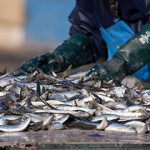Inside Nekkanti Sea Foods’ rise to prominence in India’s shrimp-export market

India has become a global shrimp powerhouse, and a plenty of credit for that rise can be attributed to Nekkanti Sea Foods.
India earned USD 7.8 billion (EUR 7.6 billion) from its seafood exports in the last fiscal year and is aiming for USD 8.8 billion (EUR 8.6 billion) in exports this fiscal year, which ends 31 March, 2023. And while India’s shrimp production is expected to fall to between 650,000 and 700,000 metric tons (MT) in this fiscal year, down from 850,000 MT in the year prior, it remains distinguished among the world’s shrimp superpowers, retaining its crown as the top supplier to the coveted U.S. market for the past nine consecutive years.
Founded by NSR Murty in 1983 in a leased processing facility in Kakinada, India, Nekkanti Sea Foods has become one of India’s largest shrimp exporters, producing 32,000 metric tons of shrimp annually and earning INR 22.5 billion (USD 272.6 million, EUR 257.3 million) in revenue in the 2022 fiscal year. It now operates five shrimp-processing facilities, including one of the largest in India, a 110-acre complex built in 2018 dubbed that can churn out 100 metric tons of processed shrimp per day. In 2022, it opened its first dedicated breading plant at a cost of INR 250 million (USD 3 million, EUR 2.9 million), with the aim of becoming a leader in the country in producing high-value-added products, according to Venkat Nekkanti, the company’s managing director and Murty’s son.
Over the first 20 years of the company’s existence, the company diversified into operating four trawlers catching wild-caught shrimp and rock lobster in India, Sri Lanka, and Mynamar. In 2004, the company was hit with two major setbacks with the imposition of a 10 percent anti-dumping duty by the United States and the rise of vannemei shrimp in the global marketplace.
“It was a double whammy. We were stuck with black tiger shrimp and higher duty rates,” Nekkanti told SeafoodSource.
After graduating with a bachelor’s degree from Virginia Tech and enrolling in an MBA program, Nekkanti – then 21 years old – was asked by his father to help lead the company’s response to the duty crisis. Specifically, he was placed in charge of the company’s designation as a mandatory respondent to the first U.S. period of review (POR). Eventually, after a significant effort on behalf of India’s nascent shrimp sector, the antidumping rate was lowered to 7 percent, and further reduced to below 2 percent in subsequent reviews.
“There was a lot of work and a lot of learning,” he said. “It was baptism by fire for me.”
Nekkanti and his brother, Mahesh Nekkanti – now the company’s executive director – eventually took on the mantle of leadership in the company, with Murty moving up as Company’s Chairman. They were tasked with maintaining Nekkanti’s top-three position in shrimp exports. By 2006, Venkat Nekkanti was focused on two tasks – clearing bad debt off the company’s books, and developing a strategic outlook that would guide Nekkanti Sea Foods’ future actions.
“At the time, we were one among the many for our customers. So that's when we started to kind of narrow down what we were doing. We started concentrating a little more on the bottom line and a little more on the customers that we were working with,” Nekkanti said.
In 2010, vannamei made its entrance into Indian shrimp cultivation, allowing the country’s shrimp firms to better compete on the world stage. It was that year Nekkanti had leveraged their strong & ethical relationship with Eric and Lee Bloom, the leaders of Eastern Fish Company.
“I really liked the brothers. They were no-nonsense, just straight to the point. Basically, I flew all the way from India to have a 15-minute meeting and then back to India. We didn't have much to offer, just a few containers of black tiger shrimp that represented a small part of their volume. But they asked us if we could get a large-sized vannamei to substitute for black tiger. We went back to our farmers and said we would buy at whatever size they harvested from 16-20 up, and we guaranteed a price to them. That was possible with the backing of Eastern and their retail connections,” Nekkanti said. “We kept looking for things that would really set us apart and allow us to separate ourselves from the commodity game.”
“My success came when I realized we could only be good at two of the three important things when it comes to selling shrimp – speed, price, and quality. We chose quality and timely shipments and we chased that. And because of that decision, that strategy, we had to get a premium price because to offset all of the costs to get good at the other two things. But we sold a lot of shrimp and the premium was maintained by that,” Nekkanti said.
Nekkanti said it was his goal to have his company avoid the cutthroat competitive bidding environment some U.S. retailers aim to create by splitting their orders between multiple suppliers. By working with buyers who were more exacting in their quality requirements, the company slimmed down the numbers of rivals it faced, and once it had contracts in hand, Nekkanti said the company worked hard to overdeliver on its promises.
“We were agreeing to surprise audits, where inspectors would walk into our factories unannounced,” he said. “So we had to commit to performing constant upkeep on the factories – investing in them and making sure all the [standard operating procedures] were maintained at all times. We had to maintain that hygiene level in the factory and the operation in the factory on a constant basis being a BRC-certified facility and to maintain our sustainability credentials like [Best Aquaculture Practices] and [Aquaculture Stewardship Council].”
That commitment has also required tighter integration with Nekkanti Sea Foods’ contracted farmers, who need to be taught the importance of maintaining higher standards across their collective 7,000 acres of farms.
“We're incentivizing them to adopt best practices because we paying for all the actual certifications, so that all they have to do is just fulfill their requirements,” Nekkanti said. “A lot of these farmers have grown with the company. We have at least three farmers who started off as 30- to 40-acre farmers and are now at 500 acres. The larger farmers who are looking for better business opportunities, we support them in improving their practices and doing what they need to do to meet our standards.”
Nekkanti Sea Foods maintains its own broodstock, hatchery, and 500 acres of its own ASC- and BAP-certified farms, with plans to up that total to 1,000 acres in order to better control supply. Having locked down a solid market for its frozen shrimp, Nekkanti is now moving further into value-added products, having invested USD 15 million (EUR 14.2 million) in upgrades to equipment, including the addition the breading facility with two lines, upping its total number of Laitram Machinery cookers to six, the highest number of Laitram vision graders in India, and the addition of a liquid chromatographic mass spectrometric (LC/MS/MS) machine inside its factories to completely ensure compliance with U.S. Food and Drug Administration limits on antibiotics and other impurities. That addition was particularly important after Nekkanti Sea Foods ended up listed on an FDA import alert in May 2022 after one of its entry lines was refused entrance to the U.S. due to the presence higher-than-acceptable amounts of nitrofurans.
Venkat Nekkanti blamed the issue on margins of error caused by less-accurate machines used before the LC/MS/MS analyzers were installed. With quality assurance being a key deliverable for the company, Nekkanti said he was happy to invest in machines that will ensure contaminants are never found in the company’s products again.
“The whole process has to be done right to get the right result,” he said.
Currently, around 25 percent of the company’s products can be classified as value-added, but Nekkanti’s eventual plan is to raise that total to 50 percent. For 2023, Nekkanti has set the goal of having 30 to 33 percent of the company’s total sales be value-added products. He also wants to grow the company’s raw shrimp sales but said plans to expand that category were harmed by Covid-related delays in infrastructure upgrades.
In 2022, the United States accounted for 90 percent of Nekkanti Sea Foods’s exports. Venkat Nekkanti acknowledged the company is “very U.S.-centric” but said he’s comfortable with that “as long as we continue to have the right partners there.” He said he’s not worried about rising competition in the U.S. market from Ecuador, which recently signed an agreement with the FDA in the first step of a strategic alliance focused on shrimp exports.
“The reputation of Indian shrimp will carry us through,” he said. “Ecuador will go to their natural home of China and India have a resurgence in the U.S.”
Freight rates have returned to pre-pandemic levels, eliminating the advantage Ecuador had in the U.S. when the cost of sending a container of shrimp from India to the U.S. surpassed USD 15,000 (EUR 14,200), Nekkanti said. And the ending of China’s zero-Covid policy, which saw numerous Ecuadorian exporters banned from the Chinese market after their products were allegedly found to be carrying the virus, will further advance a return to previous trading norms, according to Nekkanti.
Overall, Nekkanti is predicting a “solid” financial performance for his company in 2023. For typical companies, that would mean a small growth in sales and profits. But for Nekkanti, which has been growing five times as fast as the overall shrimp industry in India, which itself has been growing at roughly five times the size of the global shrimp market annually, “solid” can be translated to “exceptional.”
And that’s exactly the word Venkat Nekkanti selects when describing Nekkanti Sea Foods.
“We don't want to be like one among the many,” he said. “Our tagline is, ‘I have to be as important to you as you are to me.’ As long as we maintain that equilibrium, we’ll be fine. We’ll keep looking for new markets and to new and better products for growth, but we’ll rely on our regular customers as the most-promising part of our future, because they want to work closely with us, and the feeling is mutual.”
Photo courtesy of Nekkanti Sea Foods




Share